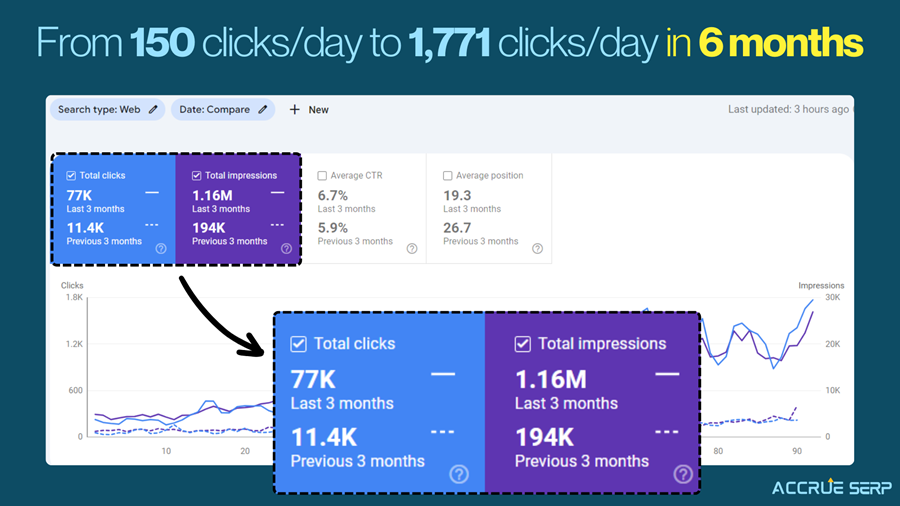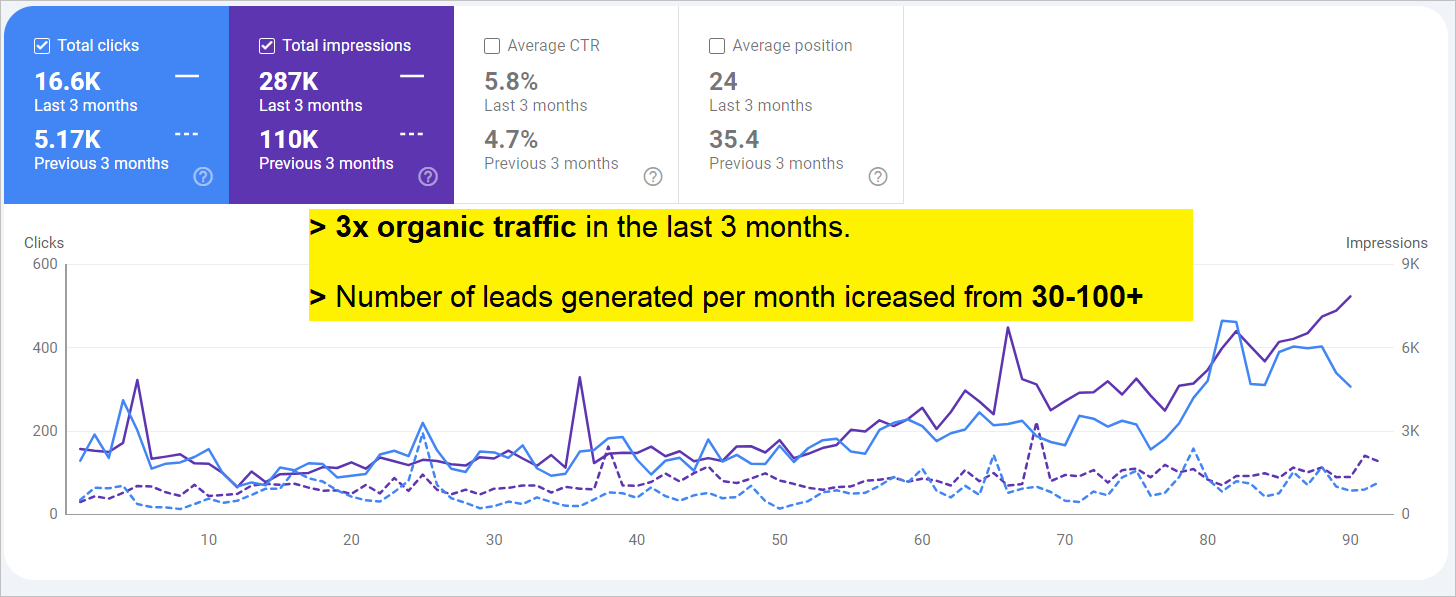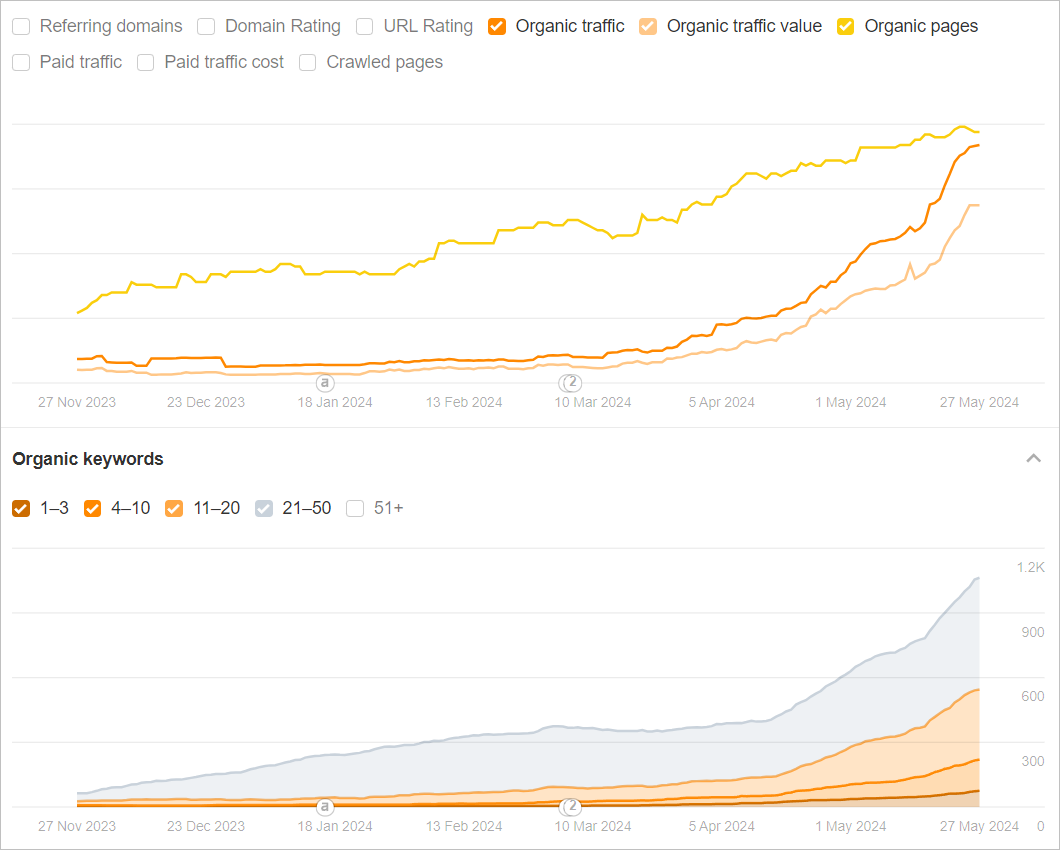How we scaled Codegnan.com’s traffic from 35 clicks/day to 1,771 clicks/day in 10 months.
- Niche: IT training courses
- Location: India
- SEO Objective: Ranking course pages in target locations

110+
Qualified leads every month
1080%
organic traffic growth in 6 months
1770+
organic visitors per day (average)
Background of the project
Codegnan.com is an IT training institute that offers classroom training to specific regions such as Bangalore, Vijayawada, and Hyderabad.
- Niche: IT training institute
- Target location: India
Branches: Bangalore, Vijayawada, and Hyderabad.
Challenges Before Working With Accrue Serp
Before we started, Codegnan had only an offline presence with a strong brand value. However, their website wasn’t optimized much with course pages and regional content.
Initially, we had the strat the SEO strategy from zero level. This includes:
- Planning the website architecture
- Planning course pages
- Planning local backlinking campaigns
- Redesigning the UI/UX of landing pages and blog articles
Results we achieved ⭐
Here’s the organic site traffic growth comparing the last 3 months vs the previous 3 months.
However, we started our SEO campaign almost 7 months from now (27 May, 2024).


Here’s the keyword growth over the last 6 months:

What we did
Here is the complete process that we followed to scale their B2B services business:
1. Market Research
We started our consultation process by understanding their target market and why they were not able to connect with the right audience.
Insights from the research allowed us to understand the major issues with their business model and what alternative approach we can work with.
Also, we analyzed several competitors to prepare a plan for the pivot and scaling of the business.
2. Pivot Strategy
Based on our research, we strategized the pivot strategy and suggested the following changes to the team:
- For the Indian market, a fully managed service model would be better instead of a mediator model for the content industry.
- A team of in-house and contract-based freelance writers will be created to provide high-quality services.
- The content process will also include editing and SEO-optimization activities to deliver publish-ready content.
The team accepted the suggestions and we helped them shift to the pivot in a few weeks.
3. Setting Up The Website
As we rebranded into a different brand and business model, we shifted from a custom-coded platform to WordPress. The service offerings were clear and simple and thus WordPress felt like a better option.
After setting up the basic pages, we also prepared the guidelines for:
- Service Pages to list down various services
- Location pages to target different locations
- Industry pages to target different industry-related queries
- Knowledge base to share short knowledge bytes and myth-busters
- Resources segment to share free resources for lead generation
4. Content Creation & Publishing
For all the website pages and blog articles, we prepared in-depth content briefs having actionable strategies for the team to work on. This allowed the team to set up 40+ landing pages and 7-8 articles a month.
5. Off-page SEO
With the ongoing publishing of content and service pages, we also worked on various off-page strategies to generate quality backlinks.
We worked on:
- Quality guest posts with research-based content
- Outreach-based backlinks for editorial backlinks
- Publishing link-worthy articles to receive high-authority natural links.
- Used platforms like Featured and HARO to receive editorial backlinks
- Published Startup stories on various platforms to attract genuine links and mentions
6. Lead Generation
Each and every landing page was optimized for lead generation. The pages had three lead generation forms as shared below:
- A form in the hero section to take content requirements.
- A form in the middle of the page to let users download samples by providing their details.
- A form at the very end with some USPs and a free consultation CTA.
Apart from that, every blog had CTAs and in-line resources attached to generate leads from organic visitors.
This allowed them generate quality leads on a consistent basis.
What we did
Here’s a quick overview of tasks that we implemented:
1. Strengthening the Website’s Foundation
- Created the money pages (service/course)
- Fixed the on-page optimization
- Invested in custom schema
- Worked on the UI/UX of the pages
2. Starting the Backlink Campaign with the Homepage
We have started the website’s backlink campaign with the homepage. We acquired strong backlinks to the homepage to pass the PageRank from the homepage to our key money pages.
This way, even without page-level backlinks, the homepage authority adds some value to these pages, given a solid internal linking structure.
3. Ensuring GMB and NAP Citations for Local SEO
As this business operated in three different cities of India, we created numerous NAP citations for these locations from the beginning. These backlinks don’t directly help rank the service pages but act as trust signals in search engines and add local relevance.
4. Starting Blog Content with BOFU Stage
Our content strategy started with the blog content with the BOFU stage. We began the blog content strategy by covering the BOFU topics first.
For example, for an IT training institute, we targeted BOFU keywords such as “{course_name} syllabus” and “{course_name} course fees” to generate leads. We will later expand the content width by targeting other types of search topics.
5. Working on Service Pages’ Ranking One by One
We have worked on ranking the service pages one by one. In the second phase, we started our link-building strategy (including paid content collaborations).
We created a sheet listing the key pages we should rank on the first page and their respective current ranking positions.
We then tracked the ranking position after executing backlinks.
Instead of targeting all pages at once, we started creating links for 1-3 pages at a time, helping us stay focused and create more quality backlinks than our competitors.
